




Ispent my early career in HR in large retail organisations in the United Kingdom. It sometimes felt like one month I was on a conveyor belt of disbanding and rejigging teams, and then the next month I was hiring and designing new organisational structures and teams. The yo-yo effect was strong! Yes, we’re told that change is inevitable and nothing ever stays the same, but it felt like these change initiatives weren’t really grounded in a strong purpose. And they certainly didn’t seem to make the organisations more human.
But that was 15-odd years ago!
Perhaps we didn’t realise then that it’s the human-to-human interactions that matter most. We didn’t fully recognise that organisations are full of people with hopes, dreams, stories and problems. We didn’t realise that we don’t work for an organisation, we work for a boss, each other, and our team.
This issue of Human Resources magazine looks at the theme of Change Management. With a change of government in Aotearoa at the
end of last year, things in the public sector will inevitably also change. With high interest rates, high inflation and a crunched cost of living, jobs could be at risk. With the arrival of ChatGPT and other AI-based tools, technology has and will continue to evolve and change. And with the ever-warming planet, our climate, and hence all our actions, are set to change. The one thing all these changes have in common is that it’s we, as HR professionals, who will inevitably be the ones implementing them.
In our feature articles this issue, Digby Scott, change maker and change expert, writes on what HR can do to lead through change. Leanne Holdsworth, author and change consultant, looks at what mindsets we need to humanise the workplace through change. We also look at what some HR people have done to make change more human in their organisations, and we delve into how HR can prepare for upcoming changes.
Amongst the turmoil of change, we also take time to celebrate our HR superstars with coverage of the NZ HR Awards 2024, which took place on 14 March in Auckland. Ka pai to all the finalists and award-winners!
Kathy Catton
Managing Editor
Kathy.Catton@hrnz.org.nz
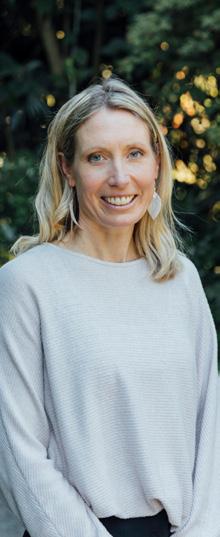
MANAGING EDITOR
Kathy Catton
Ph: 021 0650 959
Email: kathy.catton@hrnz.org.nz
ADVERTISING & SPONSORSHIP
Nikita Barends
Ph: (04) 802 3954
Email: nikita.barends@hrnz.org.nz
DESIGN
Jen McBride, Jn Creative
Email: jen@jn-creative.co.nz
PROOFREADER
Jenny Heine
Email: jenny@heine.co.nz
SUBSCRIPTION ENQUIRIES
Email: comms@hrnz.org.nz
PUBLISHER
Human Resources is published quarterly by Human Resources New Zealand PO Box 11-450, Wellington
Ph: 0800 247 469
comms@hrnz.org.nz
hrnz.org.nz
nz.linkedin.com/company/hrnz
instagram.com/hrnzphotos
The views expressed in Human Resources are not necessarily those of Human Resources New Zealand, nor does the advertisement of any product or service in this magazine imply endorsement of it by Human Resources New Zealand.
Copyright © Human Resources New Zealand Inc.
Vol 29 No: 1
ISSN 1173-7522

T h e n e w C a p a b i l i t y F r a m e w o r k , T h e P a t h , i s d e v e l o p e d f o r t h e u n i q u e d e m a n d s o n H R p r o f e s s i o n a l s i n A o t e a r o a , b y H R p r o f e s s i o n a l s . T h e P a t h h i g h l i g h t s t h e f u n d a m e n t a l f a c t o r s t o a l l o w i n g H R p r o f e s s i o n a l s t o l e a d n o w a n d i n t o t h e f u t u r e .
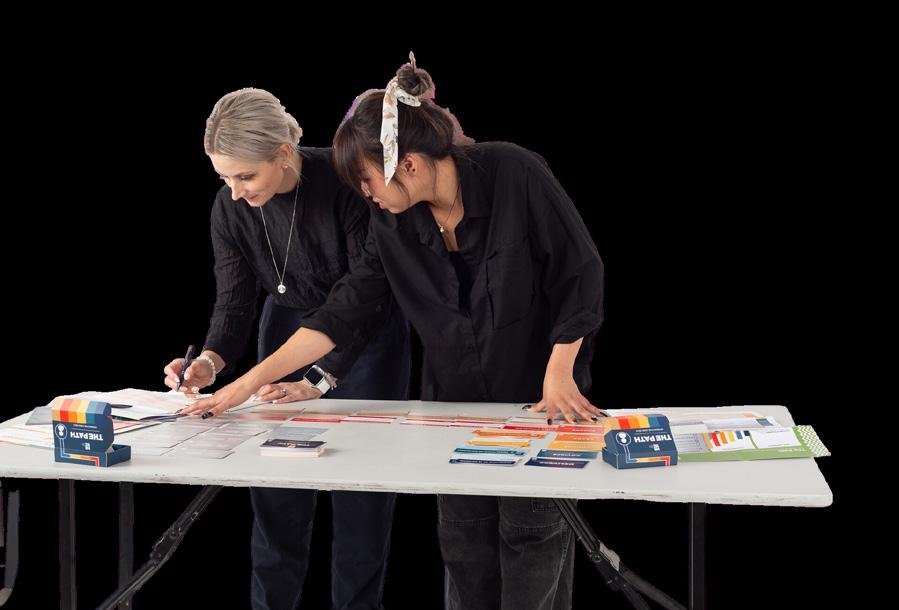


For many people employed in human resources, change management has become synonymous with restructuring. Essentially, we view change management as the thing we do when we have changes to the structure and roles within an organisation. There is often displacement of staff involved as well.
We have well-rehearsed practices for dealing with change – union engagement, consultation processes, managed communications – all designed to create positive engagement with the change process and minimise risks to the organisation.
Personally, I’ve never been involved in a change process – either leading it or being affected by it – that didn’t create some level of anxiety or stress for the employees involved. I’ve learned a few things about managing these change processes over the years, which have significantly influenced how I approach change now.
Being clear and honest about the purpose of change is critical, easy to say but not always easy to do. Often HR people are asked to communicate about change in scenarios where a fair bit of ‘spin’ is involved in putting messages
across to the employees. I was once involved in a reorganisation in which the initial communications were delivered by members of the executive team in a very polished and professional manner. This organisation had a multi-milliondollar financial problem that was presented in some very compelling charts. It was evident in listening to the presentation that the problem was real and had been developing over several years. The purpose of the presentation was, of course, to explain the burning platform driving the need for immediate and significant change. The question in my mind – and possibly others’ –was, if this problem has developed over several years why are you only taking action now? It was hard not to think that employees were about to pay the price for prolonged mismanagement of the organisation.
The prevailing fixation in Wellington at the moment is the need for cost savings in the public sector at some eye-watering levels. You have to feel for the human resources teams in these organisations as they plan their communications around the inevitable changes their organisations will face. How do you create the right messaging if it’s widely known that the purpose of the coming change is simply cost reduction, tinged with an antipathy towards the public sector?
Another problem organisations sometimes encounter is that they have decided on the actual change solution before they start communications. In this scenario, a narrative has to be created not only to explain the purpose but also the solution and to do this in a way that doesn’t appear to be a fait accompli. This is where the spin doctoring can easily start.
The golden rule around communications, of course, is authenticity. A main aim in any change process will be to build trust with employees. Treating people with respect by being authentic and not subjecting them to spin is essential to successfully managing change. Employees will immediately understand when this is not the case; trust is lost, which cannot be easily regained. At all times members of the human resources team will need to defer to the code of practice for HR professionals and ensure they are modelling appropriate ethical standards when they are involved in leading change.

26 Mastering the art of hosting Digby Scott, leadership specialist and changemaker, reveals how we can master the art of hosting when leading people through change
30 Behind the scenes of change Editor Kathy Catton talks with three companies that have recently been through a change process
34 Humanising workplaces in Aotearoa
Leanne Holdsworth, Associate with Cultivating Leadership, offers her practical actions for HR professionals seeking to humanise workplaces
38 Navigating transformational change
Three consultants from PwC’s Workforce Consulting Practice outline what areas of focus are crucial for HR professionals to consider when supporting their organisations through change
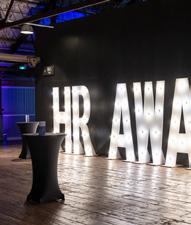





1
3
8
10
The
12
16 Employment Law Update
Getting the basics right: offers of employment –Jack Rainbow, Dundas Street Employment Lawyers, outlines the importance of getting offers of employment right from the start
18 Research Update
The HRNZ Academic Branch Committee members report back on their recent research symposium in Auckland
20 Case Law Review
David Burton, Burton Law, looks at a recent personal grievance case following a redundancy process
22 PD Spotlight
The HR Foundations programme has been updated and refreshed. Here, we look at the journey to its reinvention and what participants can expect to learn now
42 Dear Human Resources… Aidan Stoate, Inspire Group, shares his heartwarming insights into being a people leader
Check out our banners and footers!
Our articles are all tagged with the levels (see above), from our new Capability Framework, The Path
For more information, check out our website.



The latest research from Deloitte shows the way we work is changing, influenced by new technology such as generative AI, virtual worlds and neurotechnology. With change comes uncertainty but also an opportunity to focus on what people do best – being empathetic and curious – which can lead to better outcomes.
Deloitte’s 2024 Global Human Capital Trends research reveals that a pivotal focus on the human factor is emerging as the bridge between knowing what shifts are shaping the future of work and doing things to make real progress towards putting them into action to create positive outcomes.
Over 14,000 respondents across 95 countries stated that the more boundaryless work becomes, the more critical uniquely human capabilities become. According to the research, this is because the degree to which the organisation creates value for people rests on humans being able to exercise their capabilities to the highest degree to drive business performance and to shape and adapt to the ever-evolving future of work.
CELEBRATING OUR EXCELLENCE
The NZ HR Awards 2024 celebrates those within the HR profession who are excelling in their fields. Award submissions in total increased by 50 per cent this year. This year’s awards highlighted the importance of learning and development, wellness programmes and talent acquisition, and the dedication of organisations to create a positive work environment, engaging with te ao Māori and making a difference in their respective industries.
To find out more and see the winners, go to page 12 for our full review.
The Human Capital Trends 2024 report highlights the emerging trends that will define the future of the workforce as:
• embracing human sustainability
• moving beyond productivity to measure human performance
• balancing privacy with transparency to build trust
• overcoming the imagination deficit
• creating digital playgrounds to explore, experiment and play
• cultivating workplace microcultures
• making the shift to boundaryless HR.
The adult minimum wage will increase from $22.70 to $23.15 per hour from 1 April 2024. The starting-out and training minimum wage will also rise from $18.16 to $18.52 per hour.
If you have employees on the minimum wage, let them know about the increase they will be getting. Make sure your payroll provider or finance team are ready to implement the change. If any employment agreements (contracts) are not current, now is an ideal time to discuss with them in good faith. For more information, check out our HR Guides.
The independent external review into the Accredited Employer Work Visa has been released. Check it out here.
The new median wage rate of $31.61 an hour has been adopted into parts of the immigration system as of 28 February 2024. Read more here.
HRNZ’s ‘The Basics’ aim to provide HRNZ members with comprehensive and easy-to-use materials that support your daily HR operations. The Guides cover off the essentials of fundamental HR processes and procedures, and provide simple guidelines, frameworks and templates.
HRNZ continuously reviews and updates the suite of (currently 23) HR Guides to keep them current with changes to employment legislation and other relevant trends. Topics include Managing Performance Issues, Investigation and Disciplinary Process and Health and Safety at Work. Most recently a new 90-Day Trial Period Guide has been published along with a Guide on Pacific Island Employment Legislation.
To access these guidelines, join up to HRNZ, or log in to access the content if you are already a member.
Ready for a mini break from your desk? These two books and one podcast provide valuable guidance to help you in your HR role.


This book is a practical guide to designing, building and implementing a compelling employee experience strategy to improve workforce performance, develop a peoplecentred culture and drive business results. It also includes guidance on how to get stakeholder buy-in from the rest of the business and make sure that the EX strategy works for remote, hybrid and in-person working. Author Ben Whitter was recognised by Thinkers50 in 2021 specifically for his work in employee experience. This book is underpinned by primary data, research and global case studies for organisations including L’Oréal, Sanofi and Unilever.

This book explains how to achieve successful business change by engaging employees and making the transformation people-centric. Written by a leading voice in the change management industry, who has both academic and practitioner experience, this book is a practical guide for change professionals and students. Using evidence-based research, this book fully explores the human dynamic of change, explains how to promote collaboration between colleagues and shows how to involve line managers in the change process. It also includes discussion of the impact of change on employee wellbeing as well as the relationship between equality, diversity and inclusion and change.

This episode looks at how to lead organisational change in unprecedented change. Darren Evans was less than six months into his role of CEO at Calder Stewart when the ultimate curveball of COVID-19 arrived. This podcast has plenty of insights and tips on how to lead effective change, what leadership is required across an organisation and how to make that a reality.
Human Resources magazine caught up with Grace Coffey and Sean Mitchell, to ask about their careers, their paths to HRNZ accreditation and their thoughts about the role of HR in Aotearoa today.
What have been your career highlights to date?
I feel fortunate to have had so many highlights in my short time in the profession, so it’s hard to pick just one! My first highlight has to be being named as a Finalist in this year’s NZ HR Awards for Emerging Professional of the Year. I feel really privileged to be recognised alongside other practitioners in the early stages of their HR careers, and am very grateful to HRNZ for creating the space to recognise the mahi of practitioners at all stages of their careers. My second highlight has been stepping up and leading mediations and bargaining for Access, which was a big step up for me, and I’m proud of how far I’ve come with these skills since I started two years ago. Another
stand-out moment has been the opportunity to work in the Diversity, Equity and Belonging space. Being able to contribute to positive changes in the workplace has been very rewarding.
What inspires and motivates you in your career and why?
One of my colleagues always talks about bringing the ‘human’ to Human Resources, and that human side is one of the main reasons I pursued a career in HR. I’m inspired and motivated by the people I get to work with, and being able to provide them with support when needed. I also love a good challenge, and with the ongoing changes in health and employment spaces, I’m never short of motivation when it comes to solving problems.
What do you see as the challenges facing the industry and HR profession?
Our whakatauki is “ka mua, ka muri”, meaning “walking backwards into the future”. It’s a fascinating time with challenges and opportunities that may arise with new employment policies under the new government. I’m hoping the new is the old but improved – definitely a space to watch. Also challenging more generally, are AI and verification of identity, and, when receiving applications for roles, determining what is real and what is not. I think expectations around flexible working arrangements and employee benefits are a growing challenge. There’s
no doubt there are positives to flexible working, but there are also challenges in dealing with resistance to change, high expectations, as well as the implications for health and safety and workplace culture. We saw a massive shift during COVID-19 and another change since then, so it will be interesting to see how this progresses.
How has HRNZ membership helped your career?
HRNZ has been an excellent source for learning and professional development, and the courses have exposed me to topics I don’t typically engage with on a day-to-day basis. It’s also been a great way to connect with other people within the profession who are working in various industries, and I’ve found those connections to be really valuable in my career so far.
Please describe your journey towards becoming an Emerging Member. How was the experience?
I was inspired to start the journey of achieving my Emerging Professional accreditation after attending the NZ HR Awards, seeing what all the winners had accomplished, and seeing an opportunity for what I could achieve myself. I found using The Path and working through the accreditation process to be really helpful for my personal development and for identifying areas where I can improve.
What have been your career highlights to date?
I am incredibly grateful for everything that my career has involved so far. I am always proud to talk about my personal journey into HR, following my experience working as a manager in a McDonald’s restaurant. It speaks to my pride in working for McDonald’s, where they offer world-class training and can support dream careers beyond making burgers. Within my current role there have been so many highlights, from seeing our employees successfully get involved in a national peer recognition campaign to stomping the curve on our previously concerning turnover trend on the back of COVID-19. One of my favourite memories, however, will
always be back to the first time I completed filming in a restaurant. It was for New Zealand Sign Language Week in 2021, and I had the pleasure of working alongside Sharmila, a crew member from one of our Auckland restaurants, to create a series of videos with common words or phrases in NZSL. Sharing her story and seeing her joy in being able to help teach others in NZSL was so special. What inspires and motivates you in your career and why?
One of the amazing things about my role is that my work has touchpoints with over 12,000 people who currently work within McDonald’s New Zealand. I know that within HR there can rarely be a one-size-fits-all approach, but I love knowing that, with my work, at least one of those 12,000 will benefit. This impact is what motivates me. Being based in a corporate office separate from the hustle and bustle of our restaurants means it’s important for me to take time to connect with our restaurant employees, not only to hear feedback on what could be done better but to refuel by seeing and hearing some of the impacts from both my and my team’s work in HR.


What do you see as the challenges facing the industry and HR profession?
I think one of the biggest challenges in the industry is the nature of HR itself. It’s clear that a positive employee experience cannot only be influenced by an HR practitioner. It is just as crucial for our business leaders to be versed in positive practices amongst every other part of their roles. At my level in my HR career, I try to prioritise simplification of resources, tools and initiatives in any task I’m doing to ultimately empower our managers in our restaurants to grow their people and culture. Where this becomes more challenging is with the fluctuating HR environment that we operate in and that we need our leaders to both understand and invest in. A great example occurred last year with the
Fair Pay Agreements, which required our managers to be brought along on the journey to introduce this new legislation, for it to then be subsequently withdrawn and leave businesses wondering, “So what was the point of us doing all that?”. How has HRNZ membership helped your career?
Entering the HR field after operational roles within the restaurant brought about some challenges for me. While I had completed some papers in employment law as part of my Bachelor of Commerce with the University of Auckland, I was lacking formal training and experience in this space outside of my responsibilities as an assistant restaurant manager. By offering HRNZ membership, McDonald’s helped to support me with this, with HRNZ resources, trainings, events, and more to further my knowledge and skills. As I continued in my role, I have seen the benefit of working towards the formal EPMHRNZ accreditation in 2023 to help improve my networking and experience within the wider HR industry. I’m extremely grateful that this has led to my nomination in the Emerging HR Practitioner category for the NZ HR Awards.
Please describe your journey towards becoming an Emerging Member. How was the experience?
The process for becoming an accredited member was great. It was a little daunting at first, but then when I went into the details of what was required, it became apparent that a lot of this work (primarily in completing activities to obtain the necessary CPD points) had already been completed through my development and training with HRNZ and other training organisations. My team was really supportive of the process, and it was great to reflect on some of my and my team’s achievements when completing my application. I’m looking forward to continuing my journey with HRNZ towards Chartered Membership.

The 25th year of the NZ HR Awards attracted 500 attendees, who gathered together for the night in Auckland to connect and celebrate success across the HR industry.
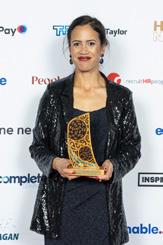

Organised by HRNZ, in association with Principal Partners AMP and enable.me, the NZ HR Awards are the pre-eminent accolade for human resources management in Aotearoa New Zealand. The Awards provide the perfect opportunity to reflect on, appreciate and celebrate all the hard work across the profession over the past 12 months, and recognise excellence across numerous award categories.
For a complete list of winners, go here. Special mention goes to the winners of HR Person of the Year, HRNZ Supreme Award winner and the winner of the Outstanding Service Award.
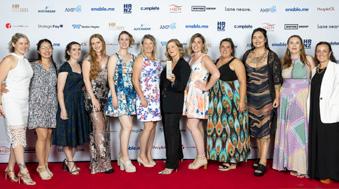
The HR Person of the Year Award is the individual award winner selected from those who have shown the greatest overall leadership in HR practice. It was a special night for Karli Te Aotonga, who won the Mana Tangata –Leader Māori HR Award and the HR Person of the Year Award. Karli is known as an outstanding HR leader of the future. She is energetic and committed, and her energy brings people together. All of Karli’s work results in tangible improvements in outcomes for Māori in the workplace at a national scale.
The Strand Veterinarian won the HRNZ Supreme Award for the organisation showing the greatest overall leadership in HR practice. Also winners of the Wellness Programme Award, The Strand Veterinarian came away on top, thanks to its hard mahi on its Vet Thrive Six Shield Programme, which helped the company achieve a lower staff turnover rate.
The Outstanding Service Award was presented to Julia Stones. Julia has led a remarkable journey shaped by resilience, passion for
justice and dedication to HR excellence. Beginning her career as a linguist and transitioning to marketing before finding her calling in recruitment, she eventually settled in New Zealand in 2005. Over the next 14 years, she dedicated herself to volunteering with HRNZ, making a significant impact as Auckland Branch President and contributing to various HR initiatives. She also served as an HRNZ Board Director for 10 years.. Her commitment to excellence and service has earned her recognition as a Distinguished Fellow of HRNZ.
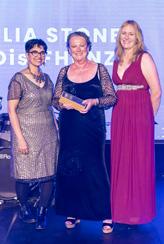
The Individual Awards recognise leading HR professionals across Aotearoa. These professionals make a meaningful difference, champion change and lead HR best practice.
HR Professional of the Year, Natasha Holloway CMHRNZ (Fliway Group) serves as the General Manager – HR, Safety and Communications. As a vital member of the executive team, she oversees all aspects related to people within the company. Natasha works closely with C-Suite executives and general managers to ensure the company achieves its overall goals. Over her 12 years with the business, Natasha has implemented various initiatives to create a better and safer work environment. These efforts have resulted in reduced turnover, increased engagement, improved safety culture and more.
Mark Lewis, the Head of People and Culture at Connetics and recipient of the Leadership Award, has assumed responsibility for managing the people aspect of the business, including operational HR, talent acquisition and management, and organisational change and development. Upon his arrival, the organisation encountered significant challenges. Mark’s exceptional leadership and expertise in various areas enabled him to empower his team to quickly tackle these challenges, resulting in the stabilisation and growth of a skilled workforce.
Emerging HR Practitioner of the Year Award went to Grace Coffey, the Senior Employee Relations Advisor at Access Community Health. Grace provides strategic advice to senior leadership, oversees professional development for a team of HR administrators, assists with the resolution of employment issues, creates and maintains policies, is a driver for projects within the People Function and holds the role of Union secretariat. Grace is

The Mana Tangata Māori HR Awards recognise individuals or organisations that incorporate significant bicultural HR practices into their work, enacting tikanga Māori.
passionate about creating a fair and inclusive workplace for all Access kaimahi.
Letisha White (University of Otago), Student Ambassador in 2023 and current member of the HRNZ committee, is the winner of the HR Student of the Year Award. As an HRNZ Student Ambassador, Letisha organised three impactful events, including ‘Korero with Professionals’, inspiring students to join HRNZ. Her role at the Career Development Centre, along with studies in employment relations, leadership and strategic HRNZ, is equipping her for a career in HR.
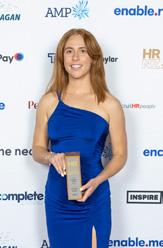
Te Whatu Ora – Tū Tangata Tū Rangatira has won the inaugural Emerging Māori HR Award for its Māori Leadership Development programme Tū Tangata Tū Rangatira. This programme combines researchbased examples from both Māori and Pākehā leadership methods to develop its Māori workforce. The programme has surpassed expectations, leading to increased engagement and wellbeing scores, decreased staff turnover, enhanced diversity and awareness internally, and improved engagement with mana whenua and understanding of the communities Te Whatu Ora serve externally.
The Leader Māori HR Award was presented to Karli Te Aotonga. Karli is driven by her commitment to represent and uphold the collective aspirations and values of her whānau, hapū and iwi, viewing it as her born leadership obligation. In her role as Manager Ao Māori Capability at Te Tāhuhu o te Mātauranga, Ministry of Education, Karli has spearheaded systemlevel change, guiding others in delivering Māori leadership advice to enhance Māori–Crown Relations capability. She has significantly shaped the knowledge base of the HR profession in Aotearoa by co-creating HRNZ’s pilot Transforming HRM programme. Karli has also achieved a Master’s degree and embarked on a doctorate focusing on Māori and indigenous thesis.
Flight Centre Travel Group received the Talent Acquisition Award for its innovative approach to address the candidate shortage. The company’s initiative showcased
exceptional leadership, thorough problem analysis and solution development. It prioritised diversity and inclusion and devised innovative solutions such as an alumni communications channel, internal career pathways advice, and revamped advertising and interview processes. These efforts led to a substantial increase in their candidate pool and a more efficient hiring process, demonstrating their commitment to innovation, HR leadership and fostering an inclusive workplace.
Coastguard Tautiaki Moana received the Learning and Development Award [Small Organisations] for its Learning Management System, which offers a modern and self-paced learning experience. This system has improved the volunteer experience, leading to better retention and reducing the risk of not having enough trained volunteers for their mission of Saving Lives at Sea. It also helps ensure health and safety and lays the groundwork for workforce planning.
The Learning and Development Award [Large Organisations] went to Tauranga City Council for the implementation of its People Leadership development programme. This initiative aimed to tackle identified organisational and cultural issues that were hindering its ability to deliver transport and housing enablement infrastructure. This programme has resulted in a significant increase in staff engagement, commitment and productivity.
Chorus received the Diversity and Inclusion Award for its DE&I Strategy, which aligns with its refreshed business strategy that is focused on promoting “a diverse, inclusive and adaptive Chorus” and collaborating on the Sustainability Pillar of ‘Thriving People’ as core objectives. These objectives have gained significant traction across Chorus. DE&I initiatives and programmes are well supported and integrated into the company’s Learning and Development programme.
Chorus continues to enhance diversity at leadership levels and within its talent pool.
The Wellness Programme Award was awarded to The Strand Veterinarian for its Vet Thrive Six Shield Programme. This initiative helps the company to identify and protect employees from psychological hazards in the workplace. The company’s mental health and wellbeing programme has contributed significantly to its ability to recruit and retain veterinary professionals. Despite global shortages in the veterinary field, the company has achieved a lower staff turnover rate.
Port of Auckland won the Future of Work Award for its Culture Strategy, promoting strong collaborative relationships between management, unions, frontline workers and the Taumata responsible for Māori outcomes. The strategy emphasises a ‘High Performance, High Engagement’ approach, prioritising respectful engagement and collaboration with all stakeholders. This cultural shift has been recognised by unions and other stakeholders as a significant change, leading to notable improvements in safety, customer satisfaction and commercial performance for the Port. It marks a remarkable turnaround for the organisation.
The Building Sustainability through People Award went to Hind Management and Sudima Hotels for its comprehensive sustainability initiative, integrating sustainability into all aspects of its operations. The company established a diversity, equity and inclusion framework, formed ‘Care Teams’ for environmental sustainability and prioritised inclusive recruitment practices. Through cultural realignment and employee training, the company achieved remarkable improvements in employee engagement and sustainability milestones, including Toitū carbon certification for several hotels. The company’s commitment to diversity is reflected in leadership composition and employee demographics, creating an inclusive workplace culture where everyone feels valued and empowered to contribute. The Waikato Branch committee has been awarded the Volunteer(s) of the Year Award for their outstanding contributions. Their Member Engagement and Connection Plan, implemented in 2023, has resulted in significant positive outcomes, including increased event attendance, enhanced social media presence and growth in Branch membership and participation.



In HRNZ’s second of a series of articles on getting the basics right, Jack Rainbow, Associate at Dundas Street Employment Lawyers, outlines the importance of getting the offers of employment clear and correct.
Making an offer of employment, even verbally, is the first step in creating a legally binding employment relationship. If routine background checks are
still pending, such as reference checks, a criminal record check, work-visa check, or a drug test, the employer must be clear about the conditional nature of the offer when it is being made.
Under the Employment Relations Act 2000, an employee is defined as any person of any age employed by an employer to do work for hire or reward under a contract of service.
The Act also extends that definition to include “a person intending to work”. A person intending to work is a person
“who has been offered, and accepted, work as an employee; and intended work has a corresponding meaning”.
This means candidates who have accepted an offer are ‘employees’, and given their employment status, the employer cannot unilaterally withdraw the offer of employment once it is accepted, even if the employee has never stepped foot in the workplace.
In Lescure v Hoki Dental Ltd, Hoki Dental contacted Ms Lescure to ask if she was still interested in a position with
the company, after Ms Lescure had previously inquired about a potential role with the company.
From there, she attended an interview and was advised that Hoki Dental would like to offer her the job. A draft contract was forwarded, and the parties exchanged questions and answers. Finally, Ms Lescure noted “everything looks perfect” and asked about changing the start date.
Subsequently, Ms Lescure was advised that circumstances had changed and Hoki Dental could no longer offer her the position. Ms Lescure raised a personal grievance claiming unjustified dismissal and took her case to the Employment Relations Authority.
The Authority found that she was an ‘employee’ because:
• Hoki Dental had made an offer of employment to Ms Lescure by sending the draft contract
• Hoki Dental did not specify any particular mode by which the offer could be accepted, and it was quite common for employment relationships to be formed without the formality of a signature
• Ms Lescure “unequivocally” conveyed her acceptance of the offer in her response (“everything looks perfect”)
• Ms Lescure’s request to change the start date did not undermine her acceptance of the offer of work, noting it was not uncommon for the parties to discuss the start date, without the formation of the employment relationship turning on that point.
The Authority found that Hoki Dental’s unilateral withdrawal of the offer amounted to an unjustified dismissal.
Similarly, in Blissett v Te Roroa Whatu Ora Trust, the Trust entered into discussions with its contractor (Mr Blissett) about making him an employee.
A committee was set up to negotiate the terms and conditions of Mr Blissett’s employment agreement, and Mr Blissett emailed
a number of negotiation points he wanted to discuss.
The Board later decided not to proceed and withdrew the offer of employment. Mr Blissett raised a personal grievance claiming he had been offered employment in the Board meeting, and had accepted on the spot, and was therefore an employee.
The Trust disagreed, claiming that, while there was an original offer, Mr Blissett had made his own counter-offer by way of negotiation points, and therefore had not accepted the original offer of employment.
Mr Blissett took his case to the Employment Relations Authority, which found that he was in fact an employee who had been unjustifiably dismissed when the Trust withdrew the offer of employment, noting:
• an offer of employment can be accepted, even if the parties have not finalised a job description and employment agreement; and
• acceptance of an offer, can be communicated by words, actions, a combination of both, or even silence in some circumstances.
Conditional offers of employment stipulate that the offer of employment is conditional on specific requirements being met. In some cases, these can be relied on by an employer to withdraw an offer.
In Edwards v Laybuy Holdings Limited, Laybuy Holdings Ltd (LBH) made Mr Edwards an oral offer of employment, noting that it would be subject to a number of pre-employment checks. He was then given a written offer of employment, which noted that the offer was “conditional upon satisfactory pre-employment checks specific to the role we’re offering you”.
LBH was not satisfied with the results of the criminal background check and subsequently informed Mr Edwards they were withdrawing the offer of
employment. Mr Edwards claimed he was an employee who had been unjustifiably dismissed. The Employment Court considered the legislative history of the definition of an ‘employee’. It noted that, in a general sense, the Employment Relations Act 2000 had departed from a strictly contractual approach to employment, with the emphasis being on the relationship between the parties. However, Judge Holden considered that the terms ‘offer’ and ‘acceptance’ had longaccepted legal meanings under contract law, and a contractual interpretation was necessary. Ultimately, the Court concluded that no employment relationship existed. LBH had made it clear that the offer to employ Mr Edwards was conditional on its pre-employment checks being satisfied. Judge Holden emphasised that LBH had made it clear they did not intend to be bound to employ Mr Edwards, despite his acceptance of the offer.
It is important to note that these cases, like most employment law matters, turn on their facts, and in particular the wording of any offer of employment. Where an employer wants to make a conditional offer of employment, it must be clear to the prospective candidate that there is no intention to form a relationship until those conditions are met, and that the employer reserves the right to withdraw the offer should those conditions not be met.

Jack Rainbow is an Associate at Dundas Street Employment Lawyers. Jack has strong experience in industrial relations, dispute resolution and providing highlevel, strategic advice. He partners closely with his clients, providing advice and assistance from start to finish on a range of complex matters.

The HRNZ Academic Branch Committee met on 4 December 2023 for a fullday research symposium, hosted by the University of Auckland Business School.
Professor Fiona Edgar, Head of Department, Department of Management, University of Otago, reports back here.
The symposium aimed to share our knowledge on the latest research in HRM, network with our NZ-based HR academics and create a platform for HR academics to develop professionally and receive feedback on their research.
During the morning session, the committee reviewed its 2023 achievements, finalised the 2024 goals and shared research interests for input and collaboration. An overview of some of that research is noted below.
In the afternoon session, we opened our symposium beyond
our committee to share the following with the University of Auckland Business School staff and PhD students.
HRNZ 2023 MEMBER VOICE: SHAPING THE PROFESSION ANNUAL SURVEY
Our Academic Branch Committee member
Professor Jim Arrowsmith manages this survey and discussed results on crucial HRM trends and challenges, such as recruitment and retention pressures, including in HR, technology and analytics, training and development, including that of managers. In terms of HRNZ’s domains of knowledge, results
showed that progress has been made in HR administration and employee engagement, although industrial relations is becoming more problematic. Concerning HR capabilities, influence skills were reported as especially important, as well as analytical skills vital in navigating multiple and often competing demands. There were mixed perceptions of needing professional accreditation and an HR Code of Practice, although those in smaller organisations were more positive. Results demonstrated that HRNZ offerings for competency development were rated highly (see HR Trends 2023 – HRNZ Member Survey).
Apanel discussion on current and future directions in HRM research was then held, with Professors Fiona Edgar and Maree Roche and Dr Joanne Mutter as panellists and Dr Russell Wordsworth as the moderator. Three inescapable trends were discussed: sustainability, AI and wellbeing.
• Sustainability: Advance the Green agenda to ensure that HR supports the delivery of sustainability objectives in the organisation.
• Hybrid work and future of work: Conduct research that examines the impact of COVID-19 on alternative work arrangements, what should continue as good practice, why organisations are winding things back and reaction to this. Examining how the ‘future of work’ has evolved post-pandemic and that of the gig economy and precarious work.
• Artificial intelligence: AI’s impact on the nature of work and the types of jobs available in the future. For example, its effect on the HR function and how we recruit, select, develop, reward and retain human capital.
The panel also discussed the challenges in the research space, particularly how we make sure our research has impact and value to a
practitioner audience, and how to balance the tension between publishing quickly and having industry relevance.
At the University of Canterbury, Sarah Wright is looking at the interesting topic of loneliness in the workplace and understanding how work practices can lead to relational connection and disconnection at work. Russell Wordsworth is looking at how people experience and respond to being ‘trapped’ in jobs or organisations they would prefer to leave. Referred to as ‘reluctant staying’, some employees choose to ‘wait it out’, others sit in a holding pattern or reframe the situation.
At the University of Otago, Nataliya Podgorodnichenko is leading a research team looking into how sustainable HRM is evolving in Aotearoa New Zealand workplaces and what role HR practitioners play in driving sustainability. Paula O’Kane has a body of research exploring the paradoxical tensions experienced by human resources business partners. These tensions often arise from different expectations (administrative versus strategic) and complex relationships (balancing line manager partner and the other members of HR).
At AUT, several large projects are under way. Led by David Williamson and Candice Harris, and in association with Unite Union, the largest survey of hospitality employees ever undertaken in Aotearoa New Zealand was completed. Two thousand two hundred respondents provided detailed data on sector conditions. Katherine Ravenswood is leading research that investigates workplace violence, and the role that gender, race and class discrimination may play in violence occurring at work. AUT is also home to the New Zealand Work Research Institute (NZWRI), led by Gail Pacheco. NZWRI provides multidisciplinary, inquiry-driven research with social impact.
At the University of Auckland, Joanne Mutter is collaborating with Kaye Thorn from Massey University on research into the impact of hybrid working on dual-career couples. The increasingly blurred boundaries between work and home, which are an inherent component of hybrid working, means that new boundary management tactics are required to facilitate effective work and home life. Maree Roche’s work revolves around leadership mental health and mindsets, employee wellbeing and mental health at work, and Māori leadership and employee wellbeing, particularly from a Māori kaupapa perspective.
If you are interested in any of these studies and wish to seek further information, please contact the researcher.
Candice Harris (AUT)
Craig Robertson (Unitec)
Deepika Jindal (The University of Auckland) Branch President
Fiona Edgar (University of Otago)
Jim Arrowsmith (Massey University, Auckland) Branch Secretary
Maree Roche (University of Auckland)
Mark Harcourt (University of Waikato)
Noelle Donnelly (Victoria University of Wellington)
Paul Toulson (Massey University, Manawatū)
Russell Wordsworth (University of Canterbury)

David Burton, an Employment Law Barrister, looks at a recent personal grievance case involving a lack of clarity on behalf of the employer during a redundancy process.
Successful businesses and organisations tend to be agile and need to adapt to changing circumstances. Finding the right solution for the employer is as important as managing the change to resolve the situation.
Failing to manage that change may result in the employment relationship being terminated with the employer facing substantial claims, as the employer found in the recent case of LNF v Department of Corrections in the Employment Relations Authority.
In 2019 the Department of Corrections advertised a role with a position description that was dated 2007. The intention was for the role to be split 80 per cent in one team and 20 per cent in another. While it required some administrative work in both teams, the work was at a more senior level. While the intention was to explain the position more thoroughly through the interview process, this was not successfully communicated.
Corrections has a complicated organisational structure, which was further complicated with managers and staff being seconded into alternative positions for periods of time. The situation became ‘messy’ within the first few weeks of LNF’s employment. LNF started raising issues with her managers about her role, including where she sat in the team structure. There was additional conflict with a colleague regarding boundaries between their two roles, with the colleague believing that LNF was stepping into her role.
“ The situation became ‘messy’ within the first few weeks of LNF’s employment.
LNF’s manager saw the situation as a personality conflict and suggested that LNF move into his team. LNF was not persuaded that the move would improve the situation. Matters came to a head and there was an altercation between LNF and her colleague. A mediation was proposed, but LNF was not prepared to attend this.
LNF was moved into her manager’s team on a full-time basis. Although her manager believed all the parties were content with the arrangement, LNF continued to have an issue with the lack of clarity she perceived in her role.
LNF’s manager tried to define what work LNF had been doing and to find meaningful
full-time work for her. He started discussions about “how do we fill in your day” and discussions regarding a job description. LNF began to look for other work at Corrections because she felt like she was still getting caught in the crossfire.
A formal letter was given to LNF offering her a variation of employment with a confirmation of duties. LNF did not agree and contacted her union. Numerous meetings were held with LNF and her representative. LNF received a pay rise, the explanation being that there were no performance issues because there was no job description to measure performance against. Mediation was again discussed.
LNF’s managers then considered disestablishing the type of role LNF was employed to do, on the basis that the support in the region was more administrative than advisory. LNF was the only employee in that type of role in the region, so LNF was the only employee affected. LNF provided feedback that the current state was that the role she was employed to do did not exist; that she had worked in an undefined role; and that her manager had failed to actively and constructively remedy this for two years. She said the proposal had been specifically drafted to remove her from the organisation.
After a mediation was attended, LNF was advised that her role was disestablished and Corrections would work with her to explore alternatives. There was no discussion with LNF about redeployment, partly due to there being no agreement about her tasks. Months later LNF received a formal notice of severance.
LNF raised personal grievance claims and argued that Corrections used a restructuring process to terminate her employment,
following a long-lasting and unresolved employment relationship problem.
The Employment Relations Authority agreed and found that the redundancy was not genuine and was used to justify the termination of LNF’s employment. LNF was awarded six months of lost remuneration and $23,000 compensation.
“ She said the proposal had been specifically drafted to remove her from the organisation.
As part of its reasoning, it appears the Authority thought that Corrections could have initiated a formal review of LNF’s role, and the basis of the review findings would have supported Corrections’ position. The Authority appears to have significantly downplayed the many discussions that were held with LNF regarding her role and attempts to find her meaningful alternative work.
“ LNF was awarded six months of lost remuneration and $23,000 compensation.
The decision demonstrates that it is essential in change management to clearly understand the issue, identify possible options and engage promptly with staff likely to be affected.

David Burton is an Employment Law Barrister. David has over 30 years of employment law experience in Aotearoa and overseas. His expertise is recognised by his peers. For six years, he was appointed to the Employment Law Committee of the New Zealand Law Society. Before that, he served on the Workplace Relations and Employment Law Sub-committee of the Law Institute of Victoria, Australia. For more information, visit www.burtonlaw.co.nz or email david.burton@burtonlaw.co.nz.

Jo Martell, Chartered Member and former HRNZ Director, with over 30 years of HR experience, takes us through the updated and refreshed HRNZ HR Foundations course.
In 2022, HRNZ launched ‘The Path’. This framework helps practitioners identify the capabilities they need at each stage of their career, enabling each of us to build a development plan that underpins career progression.
Our HR Foundations programme is a critical pillar in this curriculum. It has been designed to promote the confidence of practitioners new to Human Resources and People and Culture, and who are in the ‘Deliver’ and ‘Advise’ stage of their professional journey.
At HRNZ, we are keen to ensure that the development opportunities we provide continue to meet the changing needs of our members. Earlier in 2023, we checked in with a few of our ‘new in career’ HR practitioners to explore the challenges in their roles. We also
Capability Levels
Delivers
Advises
Designs
Leads
Shapes
Governs
met with some of our valued HR leaders to talk to them about their aspirations for their ‘early in career’ team members and how we would help them achieve these aspirations.
What did we learn? There were common needs that people shared with us.
First, there is a need to understand and manage key HR processes. This includes processes such as recruitment, performance and change management. It is about aligning people processes with the delivery of business outcomes, using data to identify priorities and solve problems, and understanding the employment legislation that guides our actions.
Asecond priority identified by practitioners and leaders was to build confidence and selfsufficiency, especially for practitioners experiencing situations for the first time in their HR career. HR practitioners wanted an opportunity to practise tackling problems and to put theory into practice within a safe learning environment. Leaders reflected that it was important for practitioners to deal with ambiguity, without being constrained by the belief that there was ‘one right way’ to implement a process or solve a problem. Both practitioners and leaders were looking to increase confidence when making tough calls, influencing upwards and dealing with conflict.
The third theme was connection. Many ‘early in career’ HR practitioners find themselves in sole-charge positions or situations where they have to think on their feet. Knowing where to go for information that they could rely on and access without delay –or having an HR friend they could call on – was really important to them. Therefore, it was a priority to build their professional network and know how to access HR Guides available to HRNZ members.
We’ve taken the opportunity to review our much-loved HR Foundations course and have given it a makeover. Our updated programme provides a three-day interactive learning environment, facilitated by experts and senior HR practitioners, where attendees are supported to do the following.
• Strengthen individual identity and values as an HR practitioner, and create a development plan for your ongoing growth and career progression. Explore what it means to be an HR practitioner in Aotearoa New Zealand and how you can build your confidence in respecting te ao practices and te reo Māori.
• Use several case studies to learn more about delivering and advising on essential ‘early in career’ processes, including recruitment and selection, performance management and change management. Explore how to translate people data into a narrative that you can use to engage and influence your stakeholders.
• Participate in small group workshops where you can learn from each other and build the HR networks you can call on for help and guidance as you progress in your career. Observe the approaches used by your colleagues that you can adopt as you increase situational adaptability across different scenarios and employment environments.
• Practise accessing online HRNZ guides, increasing your confidence in how and where to get information when you need it (enabling us geeks in HRNZ to keep material up to date and relevant for you).
Please contact the HRNZ National Office at events@hrnz.org.nz, if you are interested in learning more about our HR Foundations programme. Or find a date to participate in this exciting development opportunity.
An equally important theme was identity and personal credibility. This included how I want to be as an HR practitioner, what are the values that guide my behaviour (regardless of the situation I find myself in), how do I increase my understanding of and participation in te ao Māori, and how do I build my HR brand.
The HR Foundations facilitators, Debbie Dawson and Denise Hartley-Wilkins, have been involved and contributed to the redevelopment of the programme. They are excited about this new era for the HR Foundations. It takes a holistic approach around identity, purpose, and career development, combined with a focus on the essential skills needed for developing today’s HR professionals.

Aspiring to elevate humanity within organisations, Jo Martell has 30 years of professional experience in HR. Working primarily with large corporate entities, Jo has partnered with executives, leaders and professionals across a range of industries including distribution, telecommunications, airline, retail and dairy. She has operated within functions including sales, customer service, finance and corporate services. Jo is passionate about supporting people to explore ways to fulfil their potential in life and work. Jo established MPath in 2023 to provide consultancy, coaching and facilitation services to organisations and people seeking to navigate change.
HRNZ is committed to promoting the highest levels of professionalism in Human Resources practice, through professional accreditation.
Professional accreditation demonstrates your commitment to professional, ethical practice It positions you as a leading HR Professional It is an ideal way to showcase professional achievements and career-long development
HRNZ Supports HR Professionals in New Zealand to achieve recognised standards of excellence and competence in HR practice through accreditation
Support your HR team members to develop their capabilities and achieve a portable and nationally recognised standard of competence in HR.
Early career HR professionals - HRNZ's new Emerging Professional Member accreditation is the ideal accreditation for you right now It signals to employers and your colleagues that you are committed to pursuing HR as a career For more information and how to apply, please visit hrnz.org.nz/professional-accreditation/emerging-professional.
Experienced HR professionals - gain the recognition you deserve for your competency and professionalism with Chartered Membership accreditation Chartered Members are the champions of the HR profession in New Zealand Download the Chartered Membership information booklet and for more information please visit hrnz org nz/professional-accreditation





So said a participant in a recent change workshop. In this, they captured the essence of the challenges leaders face in navigating through uncertainty. As a senior HR leader, do you ever feel like it’s “a bit soupy”? Maybe even more than a bit? In my experience, this sentiment resonates with most senior leaders embarking on high-stakes transformation programmes. The quest for clear answers in the face of ambiguity can be frustrating, akin to travelling through fog. Glimpses of possibility emerge, only to
be shrouded again. How can HR leaders master the art of leading change, embracing uncertainty and creating an environment where people can thrive in a transforming environment?
Change leadership, at its core, involves bringing people together to forge something entirely new. This demands a skill set that includes being comfortable with ambiguity, knowing when to step back, and adeptly navigating through uncertainty. But how to master these skills?
Afew years ago, a client of mine was undergoing a complex global business transformation and faced a myriad of challenges. Leaders at all levels were tasked with maintaining business as usual while preparing for the impending changes. I was involved in leading workshops around the world to help leaders understand their roles, instil confidence and build the capability to navigate the transformation. During these sessions, the organisation’s senior leaders were confronted with a barrage of detailed questions from the audience about the intricacies of the transformation. Rather than providing definitive answers, the leaders surprised everyone by admitting, “We don’t know. We need you to help us figure it all out”.
“WE DON’T KNOW.”
In a culture where good leadership equates with having all the answers, that’s a pretty courageous response. Yet when was good leadership ever not about being bold, courageous and authentic?
What happened? The senior leaders’ transparency immediately shifted the dynamics, inviting participants to become active contributors rather than passive receivers. Rather than the leader being the focal point, the challenge and the ideas got the spotlight. And when ideas and questions are at the centre of the conversation,
rather than the leader, the leader can become an integral part of the conversation. The focus shifts from the person to the question.
This approach, rooted in acknowledging uncertainty and seeking collective solutions, aligns with the principles of managing complex challenges, as outlined by Dave Snowden and Mary Boone in their classic Harvard Business Review article A Leader’s Framework for Decision Making . In complex scenarios, answers emerge through experimentation and learning rather than relying on pre-existing solutions. This mindset shift opens the door for collaborative problem-solving.
When you put ideas at the centre, the conversation thrives. This example is a microcosm of the type of leadership that we need to experience more of in our organisations and society at large. Author Peter Block wrote a thought-provoking article called From Leadership to Citizenship where he challenges the notion of how we think about what leadership does for us. He wonders what would happen if the leader put down the microphone, came down from the stage, sat with us in the audience and had a conversation with us about the challenges we face, together.
Back to our story. Here’s the beautiful thing. In all cases, on the morning of the third day, the majority of leaders had got it. To quote one of them:
“ I came in with a huge list of questions I needed answered. Now I know I don’t need all the answers. I’m okay with working it out as we go along. I’m going to lead my team to try some new things, see what works, and learn from our experiences. I’m on board
Last year, I went to an unforgettable comedy show. As the comedian came on stage and began the show, she invited all of us in the
audience to help make it an awesome show. She said she wanted us to contribute to the experience, not just to sit back and expect to be entertained.
Guess what? As we, the audience, warmed up and got over our trepidation, we leaned in. We were no longer simply witnesses to comedy brilliance; we were a part of it.
To this day, it’s one of the best live shows I’ve ever seen. No. Not seen. One of the best live shows I’ve ever been a part of. There’s a big difference. What made the difference was that the comedian saw herself, first and foremost, as the host of the audience, not simply the hero on the stage. She created the conditions for us to get what we came for: to feel good!
Create the conditions. How can this idea apply to your leadership?
When we’re in a leadership role charged with leading change, we can operate in three modes:
HOPING: abdicating responsibility and hoping it will all just work itself out.
For sustained and thriving human performance in changing environments, we need leadership at the higher end of this spectrum, with an eco-centric focus (attention on the ecosystem in which the change is occurring) rather than an ego-centric focus (attention on the leader’s performance).
Fortunately, I don’t see too many leaders in ‘hoping’ mode. Yet, all too often, I see leaders wearing the ‘hero’ hat. That’s the hat we wear when we tell ourselves, “It’s on me to provide the answers, the direction, and the confidence that people need”.
I see it, particularly with people newer to leadership, where cultural conditioning and role modelling have taught us that this is what it means to lead.
When we wear the hero hat, we talk at people and do presentations to them. And we expect people to be clear, satisfied and motivated!
HERO-ING: taking charge yet trying too hard to control what happens and owning too much of the responsibility.
“ As a leader, people don’t need your expertise. They want an experience they can be a part of.
In times of change and uncertainty, we tell ourselves that people need information. That’s true, yet what people actually yearn for is the space and time to make sense of things, and to be involved in the unfolding process. As a leader, people don’t need your expertise. They want an experience they can be a part of.
When you’re charged with leading change, don’t just fire off more comms, or do endless ‘talking head’ roadshows with jam-packed, 20-bullets-perpage slides. That’s like pointing a firehose at me when all I needed was a drink of water.
When you’re leading change, consciously dial down your inner hero. Instead, create the space for people to engage with the information.
HOSTING: creating the conditions that enable positive change to happen.
Give them the space to talk about it, explore it and reflect on it. Invite them into the conversation and help them shape it. That’s what they need.
Go beyond merely information. Deliver a deftly crafted experience that blends information, conversation and reflection. Even better, set up the experience, and then get out of the way so people can do the work they need to do together. In times of uncertainty, people crave not just information but the opportunity to make sense of it and actively contribute to the unfolding process. As Priya Parker, author of The Art of Gathering: How we meet and why it matters , suggests, leaders should reverse engineer the desired outcome, considering what they want to be different as a result of the gathering and working backward from there.
“ What’s clear is that, in our ever-hurried world, people value space to slow down. To connect. To think.
Instead of wearing the ‘hero’ hat, what if we wore the ‘host’ hat? That’s the hat we wear when we tell ourselves, “It’s my job to create the conditions for
us to get the outcome we need”. The host brings people together. They create the conditions for people to do the work that’s needed. That work might be sense-making, or it might be decisionmaking. Or maybe it’s simply connecting with each other.
What’s clear is that, in our ever-hurried world, people value space to slow down. To connect. To think.
Influential leaders know this, and they know how to create the conditions for it.
To lead change effectively, savvy HR leaders wisely adopt the role of the host rather than the hero.
The shift from hero to host involves recognising that effective leadership is not about having all the answers but about creating an environment where collective intelligence can thrive. Like throwing a great party, great hosts know that their work is to set the scene, and then allow their guests to create the magic.
Lao Tzu’s ancient wisdom is apt here: “A leader is best when people barely know he exists, when his work is done, his aim fulfilled, they will say: ‘we did it ourselves’”.

To embody the role of a host, consciously dial down your ‘hero’ instincts. This involves:
• being comfortable with saying “I don’t know”
• inviting others to shape ideas collaboratively
• prioritising questions over answers
• listening more than talking
• devoting significant time to defining desired outcomes and the conditions necessary to achieve them.
We need to redefine what it means to lead, which is, in the end, about inspiring hearts, engaging minds and catalysing deliberate action. We need to shift from providing answers to facilitating experiences. We need to move from being the sole expert to creating an experience where everyone plays a vital role.
In the face of complex changes, HR leaders need to ask themselves, “How can I dial down my ‘hero’ and dial up my ‘host’”?

Digby Scott, is a speaker, facilitator and mentor for leaders and change-makers. His work is about deepening leadership capacity and growing collective brilliance so we can get on with tackling our organisations’ and society’s biggest challenges more effectively. You can learn more at digbyscott.com.

Kathy Catton, Human Resources magazine editor, spoke with three companies that have recently been through a change process. Here she shares their insights.
Managing change is a delicate balance of strategic vision, employee engagement and consistent communication. And there’s plenty to learn from those who have gone before us. Here we delve into two successful change initiatives and one emerging change process. The hope is that HR professionals can steer their own change initiatives towards flourishing outcomes and hence drive their organisations and their people forward productively.
This nine-year-old meal kit and meal solutions business has been through various stages of business ownership in its first decade, from entrepreneur to NZX listing. The company has ambitions to continue this growth. With this, comes a need to get clear on how they do business.
“We had a clear strategy for growth, and we wanted to get clarity and consistency on ‘how’ we do business,” says Cassie Ormand, Head of People and Culture at My Food Bag. “We had a good foundation to our culture; wanted to augment
this. We wanted to get clear on our values and embed this into all our people processes.”
Critical to the success of the initiative was involving employees as early as possible in the process.
“We wanted to understand what our people love about our culture and what we could leave behind,” says Kalleigh Mikkelson, People and Culture Manager at My Food Bag. “So we identified individuals who could become advocates for the organisation and help lead and drive this change process.”
The Senior Leadership Team (SLT) nominated these ‘Culture Chefs’ from across all functions, levels and sites. They were trained in facilitation skills and then led workshops, open to all employees, to help My Food Bag understand the gems of culture that were meaningful to their people.
“‘Growth’, ‘customer’ and ‘team’ came back as the key themes from the 17 workshops,” says Cassie. “This sums up the essence of ‘us’ and what’s important about working with My Food Bag.”
From there, a three-step ‘recipe’ for the ‘Secret Sauce’ took shape, which encapsulated the values of working at My Food Bag:
1. a full cup of ambition
2. turn customer love on high
3. top off with a dollop of teamwork.
Encapsulating the values, the Culture Chefs created a recognition programme – aptly named ‘The Saucies’ – to ensure people started using the new values and began recognising the behaviours they are looking to foster and celebrate.
“Each month people can nominate their colleagues for behaviours they have observed, and the SLT then evaluates these, and a winner for each value is announced,” says Kalleigh. Building on the success of the initiative, six leadership competencies have since




been created and eight cohorts of managers and leaders have gone through a newly designed leadership development programme.
And the proof is in the pudding, as they say, with latest employee engagement scores sitting at 4.25 out of 5 in response to the statement, “My Food Bay is somewhere I feel supported to do my very best work”. Turnover rates are down and employees comment that the workplace is friendly, collaborative and high-performing.
The care taken to foster a great culture has clearly paid off.
• Make sure your employees are at the heart of any change.
• There’s no such thing as over-communication!
• Don’t underestimate the power of your employees’ energy and passion.
• Engage with as many people as possible.
• Make change fun, memorable, relatable and engaging.
With the closure of New Zealand’s Marsden Point oil refinery in 2022, there was an immediate need for Z Energy Ltd (Z) to find an alternative source of fuel from offshore. This led to a significant and complex change to Z’s supply chain. A change programme, Pae Tawhiti, focused on managing Z’s exit from the crude oil supply chain.
“ Most crucial to the set-up of this change initiative was the use of a human-centred design way of thinking, putting the end user in the centre of the design.
“The change programme focused on the building of capability (competencies, governance, process, systems) to manage the responsibilities of this change in-house,” says Diana McAlpine, who was Head of Organisational Development with Z at the time of this change. “The role of our OD team was to design and implement the business change management and capability development to ensure Z was ready and able to safely transition to an import terminal model from Day One.”
Most crucial to the set-up of this change initiative was the

application of human-centred design methodology, putting the end user in the centre of the design. This led to the creation of three phases: transition (ie, day one), stabilisation and optimisation (long-term).
“Our engagement plan and approach was also anchored to this methodology, putting the stakeholders at the centre of the plan,” says Elicia Hill, Enterprise Change Lead.
An agile change management approach was used, with teams in squads operating in two-week sprints. “This approach meant we could identify any blockages early on, pivot as needed and regularly assess the effect of the delivery and celebrate what was going well,” says Elicia. Impact workshops were also held, allowing people to be across the change and to allow gaps to be spotted and taken into consideration.
Their learning needs assessment informed a phased approach to the capability build across the users, and a self-paced learning pathway was introduced. This included
gamification to simulate the supply chain and reinforce cross-functional teams.
“Gamification of our supply chain reinforced the crossfunctional teams’ understanding on how their role contributes to the overall effectiveness of the supply chain,” says Di.
“We also took the opportunity to utilise a Service Design Blueprint to visualise the change,” says Elicia. “This was a way of helping people understand what the change meant at an individual and team level and how their role contributes to our overall supply chain.”
The transition (from April to August 2022) happened without safety incidents or unplanned events occurring. There was no discernible change to the experience of everyday motorists refuelling their vehicles and little social media activity from customer groups. Crucially, internal capability has been built, through upskilling in fuel procurement, contract and supplier management, data and analytics, commercial acumen and fleet management.

• Put the user at the centre of the change, to better enable business ownership.
• Agile change management provides great flexibility to right-size the change approach on what really matters.
• Coach leaders to create a positive culture, which will ultimately drive delivery.
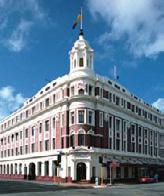
For this 150-year-old media business to survive the next 150 years, a large-scale systems upgrade is needed. To be viable in the print and digital market, and to leverage AI, security and business continuity, Allied Press recently identified the need to transition its long-standing traditional operations into the digital arena. With that, comes an inevitable impact on the people.
“We recognised the need for this systems upgrade, but equally knew that there were going to be impacts on all levels of the business,” says Christine Theissen, HR and Health and Safety Manager at Allied Press. “We have an ageing workforce at Allied Press, and a long length of service, in general. In the past, we’ve been vulnerable when people left, as we lost a lot of institutional knowledge. That means we need to build confidence and assurance within our teams that the new system is going to work and actually provide more opportunities for them.”
This reassurance and capability building also extends to managers, with frameworks in place to provide tools and communications for the upcoming change.
“We anticipate this change will take us 18 months to two years to complete,” says Eleanor Eraković, Chief Information Technology Officer at Allied Press. “Our current main challenge is working with the
fact that the digital maturity of our workforce is quite low. We need to build assurance and confidence so that people enjoy working with the new technology. That’s critical to the success of this change.”
Also to consider is how the transformation committee can support people to break some ingrained habits. “It’s normal for all of us to stay in our comfort zone and not try out new systems,” says Christine. “But we’ve been able to plan for this and have a trial run with the implementation of the Office 365 suite, for instance.”
“ We need to build assurance and confidence so that people enjoy working with the new technology. That’s critical to the success of this change.
Christine says herself that, although this change process is nothing world-shattering, it’s been a great example of how

• Engage with all levels in the business so that everyone feels they’re part of the journey.
• Make sure your leaders are setting the example and working with the business.
• Demonstrate high levels of integrity and transparency. “If decisions are political, tell people!”
• Carry out a people risk assessment and identify the benefits to people.
to get people on the journey and start to look at the bigger picture. “A select group of staff have been trained in the new systems and are now subject matter experts. Their role will be crucial in the transition as they test the system and get comfortable with it, before we go out to the business with it.”
• Be prepared for everyone to debate decisions and be part of the decisionmaking process, it will help to make everyone feel comfortable with the process if they are involved.


How do we make workplaces more human?
Leanne Holdsworth, Associate with Cultivating Leadership, offers her suggested practical actions.
At the absurdly young age of 27 I decided to throw in the towel on corporate life. The year before, I had won the Young Chartered Accountant of the Year for Auckland/Northland, and so had what seemed to be a stellar career in front of me. But I couldn’t stand another morning of getting into the lift at the office and leaving most of me in the lobby to pick up on the way back down. I couldn’t understand how the leaders didn’t comprehend that if all of me were welcomed in the workplace, if I was invited to contribute and was listened to, I could add so much more value to the business and feel
more true to who I was. It didn’t feel very human. And I thought it was just me. Until I had a lightbulb moment a few years later where I realised that this was a systemic issue, it wasn’t personal at all!
What if we could make our workplaces more human, I wondered?
Nearly 30 years later, I’ve spent most of my career supporting organisations to make their workplaces more human and their organisations more sustainable.
An average person spends 80,000–90,000 hours over their lifetime at work, more time than
we do at anything, other than sleep. By default, those 80,000 hours have a significant impact, not just on those 80,000 hours at work but also on who we are for the rest of our lives.
If we put ourselves in the shoes of someone we love: an adult, child, mother, brother, good friend, ourselves, what sort of work experience do we want for them over those 80,000 hours? And is it conceivable that this might be possible for all our fellow humans?
For the past three years, my co-author of Human Work: Five leadership mindsets for humanising the workplace and I have interviewed business leaders from around the world who are intentionally creating human workplaces, ones that support people to be at their best at work, whatever that means for them, for the benefit of every aspect of their lives and the achievement of the organisation’s purpose
Many organisations make helpful moves towards humanising their workplaces, like wellbeing initiatives, DEI policies and hybrid work policies. All these help. And it is not the same as being intentional about creating a human workplace. Policies are part of humanising a workplace. At its core, a human workplace has an intentional decision by the executive to move in this direction, including practising their way into the mindsets that support human work.
“ Imagine the positive ripple effect on families and communities if all our workplaces were truly human.
What we learned was that, rather than a checklist of the top 10 things to do to create a human workplace, there were mindsets that enabled leaders to create the conditions for humans to truly thrive. Let’s take one of those: learning and growth. Here,

we heard from all leaders, rather unsurprisingly, that leaders doing their own developmental work was crucial to creating a human workplace. Here we are talking specifically about developing more sophisticated ways of thinking and self-knowledge (vertical development). This differs from how we often hold development, which is about adding more skills, knowledge and capabilities.
And how does a learning and growth mindset make a workplace more human? Have you encountered leaders in organisations who don’t know how to listen deeply to others? Or they don’t seem able to think reflectively about their own behaviour. Or they focus all on the task and very little on relationships? Who are blind to the impact they have on others? A human workplace makes sure that learning and growth is just the water we swim in here. In a workplace that leans heavily into this mindset, you could walk around the workplace and ask anyone what their learning edge is (the place at which you don’t know what to do next, what decision to make, or how to think about something), and they would be able to tell you.
Robert Kegan and Lisa Laskow Lahey, in their book An Everyone Culture: Becoming a Deliberately Developmental Organization, help us understand the cost of not taking this mindset on as an organisation:
“ In most organisations, nearly everyone is doing a second job no one is paying them for – namely, covering their weaknesses, trying to look their best, and managing other people’s impressions of them. There may be no greater waste of a company’s resources. The ultimate cost: neither the organisation nor its people are able to realise their full potential.
With a learning and growth mindset, it is safe not to have it all together, to mess up and not get it right the first time. Let’s take one more of the mindsets: Everyone is a leader. This is what you might think of as the opposite of the old-school mindset of leadership existing only in those with formal power to direct others. Leaders in more human organisations often see leadership as the ability to take action to positively influence the organisation from anywhere. From this perspective, it is in the organisation’s best interests to increase everybody’s leadership capacity. And on this basis, everyone can be a leader, regardless of whether they have positional power or not. From a human perspective, autonomy is a basic human need. Human organisations create the conditions for as much autonomy as possible, to enable everyone to do
and be at their best. The very nature of how we relate to power as humans often makes it hard to give up the power to give others autonomy. So this mindset involves being intentional about how we use power and how we enable others to do their best with a sense that they have a say over how they do it (to the extent that their role allows this).
This is the easy question. It’s good for the individual, the organisation and our communities.
Levels of workplace stress and burnout are high. In the latest Gallup State of the Global Workplace Report, 47 per cent of the New Zealand and Australian workforce experienced stress during a lot of yesterday.
A human workplace not only looks to reduce high levels of stress and burnout but also creates the conditions for:
• more connection and understanding
• more devolved leadership
• more belonging
• greater connection to organisational purpose
• more human systems
• stronger self-awareness and empathy.
Just 23 per cent of the New Zealand and Australian workforce are engaged at work. And engagement is not contentment. True engagement means your people are psychologically present to do their work: they understand what to do, have what they need and have a supportive manager and team. They know why their work matters. They are work ready. Then the rest of us are either quiet quitting (just putting in the least effort), while 11 per cent of us are actively disengaged. At the same time,

So, we have a sense of what a human workplace is and why it’s vital to move in this direction. But what can you do in a practical sense to nudge your organisation in the direction of human work? Chances are you are already supporting this move in some ways. If you take a systemic approach to humanising workplaces, choose a few of these actions.
• Build the business case for humanising workplaces. Use the statistics in this article as a start.
• Use all your influencing skills to ensure the executive are engaged in their own vertical developmental leadership work, so they can walk the talk of a learning and growth mindset.
• Find others who care about this, even outside of HR. You won’t be on your own. Then keep talking about it together, supporting each other in your nudges.
• Make your own growth edges more visible.
• Ensure human work is included in your leadership development initiatives.
• Look for creating more agency around when, where and how people work.
• Keep championing authentic moves toward DEI and wellbeing.
• Make organisational purpose real for people. Ensure everyone knows how they contribute toward purpose.
• Make sure people feel seen.
• Ensure listening to learn is a way of being.
• Look for ways to walk the talk of humanising work; not unintentionally excluding others, listening to learn and acknowledging others.
• Use every interaction as an opportunity for someone to leave feeling better about themselves (even in tough conversations).
• Review your systems against the human work mindsets and see where you might be able to amend policies or systems (formal and informal). For instance, what policies might be working against creating the conditions for trust in the workplace?
43 per cent are watching for or actively seeking a new job.
And all of this costs an organisation in lost productivity and recruitment costs.
In March 2022, MIT Sloan Management Review published the research of Donald Sull, Charles Sull, William Cipolli and Caio Brighenti on factors causing the Great Resignation in the USA. Toxic culture was the most significant factor pushing people out the door during the Great Resignation (10.4 times more likely to contribute to attrition than compensation). And what toxic culture means to people is ‘disrespectful’, ‘non-inclusive’, ‘unethical’, ‘cut-throat’ and ‘abusive’.
One of the leadership mindsets for humanising work is ‘belonging’. What we know is that employees with a lower sense of belonging have a 313 per cent stronger intention to quit compared with those with strong social connections
and a 34 per cent lower goal attainment at work.
With 60 per cent of us believing our jobs are the most important factor influencing mental health and believing our managers have just as much of an impact on people’s mental health as their spouse (both 69 per cent), and even more than their doctor (51 per cent) or therapist (41 per cent), we can use our workplaces to turn this global mental health epidemic around. Most of us have experienced how we show up at home when we are working in unhealthy or toxic workplaces or for a manager who just doesn’t get human workplaces, compared with how we show up at home with good workplaces. Imagine the positive ripple effect on families and communities if all our workplaces were truly human.

Leanne Holdsworth helps organisations become more human. She is an Associate at Cultivating Leadership where she designs and delivers immersive, transformational experiences (leadership programmes, strategic facilitation, consulting, executive coaching) in Aotearoa and around the world. She is the co-author of Human Work: Five Leadership Mindsets for Humanising Workplaces and author of A New Generation of Business Leaders. She has spent 15 years advising organisations predominantly in the private sector (across most industries, including banking, primary sector, FMCG, tech, pharmaceuticals) as well as the public and not-for-profit sectors in leadership, sustainability and human work. You can learn more about Leanne’s work at www.holdsworth. nz and www.cultivatingleadership. com or contact her at leanne@
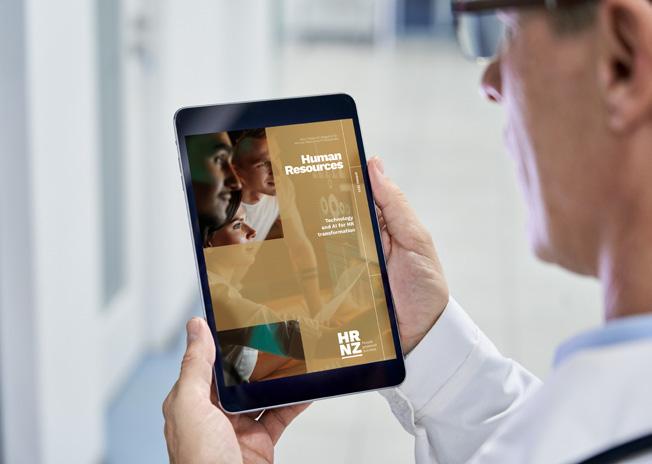

Orla Gallagher, Emma Press and Ateli Tovio, from PwC’s Workforce Consulting Practice, outline three areas of focus for HR professionals to support their organisations through transformation.
As we journey through 2024, the workforce is going through significant changes. These are driven by factors like AI, the aftermath of the global COVID-19 pandemic, the dynamics of a multigenerational workforce, the focus on ESG (environmental, social and governance) and NetZero, in addition to broader global megatrends and local waves of change in Aotearoa.
PwC’s latest CEO survey explores how organisations can thrive in this era of continuous reinvention. The survey found that 95 per cent of CEOs in Aotearoa (and 97 per cent globally)

have taken steps to reshape their business operations in response to global megatrends. Around 70 per cent of CEOs in Aotearoa (76 per cent globally) have made significant changes to their business models. While this presents opportunities for organisations in Aotearoa, it also brings unprecedented levels of uncertainty and challenge.
In this landscape of change, HR professionals have three crucial areas of focus to support their organisations throughout the reinvention journey.
1. Never underestimate the importance of culture.
and beliefs that shape how things are done within an organisation. Achieving an equal balance between strategy, operating model and culture is crucial for success.
PwC’s research reveals that organisations with distinctive cultures drive remarkable business results. They are 48 per cent more likely to experience revenue growth, 80 per cent more likely to have higher employee satisfaction, and 89 per cent more likely to achieve higher customer satisfaction. With 88 per cent of business leaders agreeing that culture enables successful internal change initiatives, harnessing your culture can accelerate your journey to success.
“ Achieving an equal balance between strategy, operating model and culture is crucial for success.
2. Invest in enhancing change capability.
3. Adapt to the needs of the multi-generational workforce. By prioritising these areas, HR professionals can guide their organisations through the challenges and opportunities of continuous reinvention.
Organisations often underestimate the profound impact of workforce culture on driving or hindering change. At PwC, we define culture as the self-sustaining patterns of behaviour, thoughts
To activate and evolve culture, organisations can leverage key enablers, such as leadership, communication, employee engagement, performance management, learning and development and organisational structure. By leveraging these enablers, organisations can align their culture with their strategic goals and drive positive change. HR professionals are in a unique position to help organisations to do this. However, culture can sometimes hinder transformation when behaviours do not align with the organisation’s direction. In such cases, HR professionals need to consider how to transform the culture to support the organisation’s objectives.
Culture is a formidable and enduring force that requires significant effort and time to transform. HR leaders can support culture change by focusing on the behaviours within the organisation. Behaviours are the enduring
ways of acting that are considered regular or expected, and link values to everyday actions: it’s the ‘how we do things around here’. By targeting behavioural change, HR professionals can achieve change more quickly.
“ Culture is a formidable and enduring force that requires significant effort and time to transform.
Identifying and prioritising strategic goals is crucial to effectively navigate challenges and achieve success. Conducting a ‘Culture Assessment’ helps organisations understand the traits and behaviours that already align with their goals. PwC offers the Culture Thumbprint, a digital tool that provides a baseline of the current culture and its alignment with the desired future state. Once organisations can see where they are, it’s
much easier to identify the change they need to make.
HR professionals can use the Culture Assessment to pinpoint a small number of key behaviours (no more than five) and focus efforts on specific areas of improvement. By using the culture enablers they already have access to, they can align learning and development initiatives with targeted behaviours, and design training programmes that reinforce and promote the behaviours that will support a more effective and manageable transformation process. Leadership plays a crucial role in driving cultural change, and HR professionals can identify and support candidates for leadership coaching to model and promote the desired behaviours. They can also review organisational values to ensure they align with and underpin the behaviours that will ultimately drive cultural change.

“ Evolving culture is not a one-time event but an ongoing effort.
Measuring the adoption of these behaviours is the next step. Establishing leading indicators, such as business key performance indicators, first-hand observations, and assessing participation levels in behaviour change initiatives, allows organisations to monitor progress and make necessary adjustments. Consistent monitoring, learning and the celebration of results are crucial for achieving sustained behaviour change and transforming culture.
Evolving culture is not a onetime event but an ongoing effort. Organisations must continuously assess and adapt their culture to ensure alignment with strategic goals and overall success.
“ Gone are the days when change management was seen as a skill set reserved for a select few in a project or change team.
According to our recent survey, 64 per cent of CEOs in Aotearoa are planning to upskill and reskill their people in the coming year. For HR professionals, it is crucial to seize this opportunity to effectively support the workforce through transformational change, while investing in their own transformation journey. To do so, they must demonstrate and instil sophisticated change capabilities across the organisation.
Gone are the days when change management was seen as a skill set reserved for a select few in a project or change team. It is now essential to embed transformation as a mindset, supported by a set of core behaviours that
enable everyone to adapt rapidly and regularly without hindering business operations. HR professionals have a unique opportunity to upskill the workforce on change and lead them through the transformation journey.
To achieve this, HR professionals need to shift their thinking and educate the organisation about change by:
• shifting mindsets to see change as continuous not ad hoc
• changing the approach from prolonged and static, to rapid and responsive (to external and internal factors)
• shifting the perception of change as being a discrete set of skills to a core capability that is essential for every professional in today’s workplace.
“ Resilience is a crucial aspect of change capability.
HR professionals should see themselves as change leaders at all levels and focus not only on upskilling themselves but also on supporting the workforce to do the same. This involves providing them with the knowledge, frameworks, tools and support to change their mindsets and behaviours. It is essential for HR professionals to demonstrate their own adaptability, as they engage with the workforce to understand what support is needed to involve them in organisational change without causing change fatigue.
Resilience is a crucial aspect of change capability. Constant change can lead to uncertainty, which can significantly impact on the workforce. HR professionals must recognise this and have a range of tools and support mechanisms in place, such as coaching and learning and development programmes, to ensure the wellbeing and resilience of both the workforce and themselves. This will help prevent burnout
often associated with high levels and frequency of change.
Today’s workforce comprises multiple generations, each with their own unique perspectives and experiences. Understanding how to effectively prepare and support a multi-generational workforce through change is crucial for embedding change capability within your organisation. It’s important to recognise that a one-size-fitsall approach does not work when it comes to people. To effectively assess how change will affect your workforce, it’s essential to understand the different generational cultures, thinking, approaches, values, expectations and life experiences that exist within your organisation. Each generation responds differently to change, and while digital natives may be more comfortable with technological advancements, older generations may be more accustomed to evolving roles and careers.
“ Each generation responds differently to change..
Thrive in an era of continuous reinvention
Creating alignment across your workforce is essential. Building alignment between leaders and employees around the organisation’s priorities for change fosters a culture of trust and transparency. Adopting a citizen-led innovation approach empowers your people to build and embed change capability and skills that can be immediately put into action.
HR professionals play a vital role in guiding organisations through transformational change. The challenges and opportunities brought by continuous reinvention demand a strategic and proactive
approach. By recognising the impact of culture, investing in upskilling for change capability, and adapting to the needs of the multi-generational workforce, HR professionals can ensure that organisations not only survive but thrive in an era of continuous reinvention.

Orla Gallagher is a Director in the PwC Workforce Consulting Practice. She specialises in helping organisations analyse and harness their unique culture to help them achieve their strategic aspirations.

Emma Press is an Associate Director in the PwC Workforce Consulting Practice. She specialises in taking a people-centred, relationshipbased approach to change, finding solutions to challenges while keeping people at the heart.

Ateli Tovio is a Manager in the PwC Workforce Consulting Practice. She specialises in working collaboratively with organisations to manage successful transformation with a holistic view that incorporates both cultural competency and long-term strategic goals to ensure sustained outcomes.
Our regular columnist, Aidan Stoate, CEO New Zealand at Inspire Group, shares his heartfelt insights into leading people.
“ Come gather ‘round people, wherever you roam And admit that the waters around you have grown
And accept it that soon, you’ll be drenched to the bone
If your time to you is worth savin’
And you better start swimmin’
Or you’ll sink like a stone
For the times they are a-changin’
Bob Dylan’s poignant social commentary is somehow just as relevant to present-day HR professionals as it was when it was first written for a very different audience 60 years ago. While the context has undoubtedly shifted, the sentiment remains: change is a constant, and much like the rising water, it cannot be subdued regardless of how much we resist. Stasis means sinking, and apathy must be replaced by action.
This is all well and good for capable swimmers, of course. But what about the fate of those who were never privileged enough to learn the front crawl, the breaststroke or simply even to tread water?
If change demands response, and response requires both willingness and competence, how do we ensure that our people aren’t left to sink like a stone amidst the rising tides of change?
Well, dear HR, this is where I believe you can all provide some crucial leadership.
You cannot transform organisations without people; any transformation will falter if those people are poorly motivated, under-equipped or lacking the agency to own the required changes.
Where many transformation initiatives fail is by addressing these considerations only after the implementation of change. New systems, product lines, policies or procedures (however well-intentioned) are often conceived by the few for the many, and are well into their initial phases of deployment before adequate communication, training or engagement with the wider organisation has been established. Then, when things inevitably start to go wrong, the ‘sink or swim’ scenario manifests. Retroactive training and development courses are rapidly set up but rarely hit the mark, and frequently neglect the appropriate messaging or adequate substance that emotionally connects people to the purpose of change.
Most people don’t want the life raft after the event; they would prefer the swimming lessons ahead of it occurring.
This is where HR can and must be the organisation’s strongest advocates for ‘people change’. The voice of the many, with the focus on preparedness heard well in advance of proposed
action: the swimming instructors instead of the lifeguards. This can feel insurmountable in the face of so much change and at such unforgiving cadence. But it can begin with three simple questions at the outset of any impending transformation: “What do our people need to believe, know and do to effectively support this?”. This is what leads to the relevant engagement, communication, learning and ownership that transforms sinking stones into Olympian swimmers. Even old Bob would be proud of that change!

Aidan Stoate is the New Zealand CEO of Inspire Group, an award-winning learning design consultancy that delivers worldclass solutions to organisations globally. Aidan has a passion for helping organisations improve their culture and performance through innovative learning and development interventions. As an ICF-accredited organisational coach, Aidan provides subject-matter expertise for the design and delivery of leadership programmes, while leading the Inspire Group New Zealand business across all projects and disciplines. Having led organisations and teams in the United Kingdom, South-East Asia, North America and Australasia, Aidan brings a nuanced perspective while promoting inclusive, engaging and contextualised solutions that drive genuine behaviour change and strategic benefits.
HRNZ is committed to helping shape the future of the HR profession through our student membership offering.
Student members gain access to studentfocused events and webinars, the HRNZ Mentoring Programme and more at just 10 per cent of the regular price!

Domains of Knowledge
HR Administration
Policy and Process Design
Diversity, Equity and Inclusion
Analytics and Data Science
Attraction, Recruitment and Selection
Employment Relations
Industrial Relations
Change Management
Health, Safety and Wellbeing
Renumeration and Rewards
Learning and Development
Employee Engagement and Experience
Workforce Planning
HR Systems and Technology
Payroll Management
Leading the HR function Organisational Development